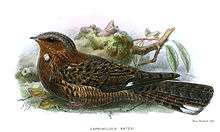Bates's nightjar
| Bates's nightjar | |
|---|---|
 | |
| Scientific classification | |
| Kingdom: | Animalia |
| Phylum: | Chordata |
| Class: | Aves |
| Order: | Caprimulgiformes |
| Family: | Caprimulgidae |
| Genus: | Caprimulgus |
| Species: | C. batesi |
| Binomial name | |
| Caprimulgus batesi Sharpe, 1906 | |
The Bates's nightjar or Forest nightjar (Caprimulgus batesi) is a species of nightjar in the Caprimulgidae family, which is found in the rainforests of western Sub-Saharan Africa.
Description
Bates's nightjar is a large, dark nightjar. At rest looks large headed and long tailed. The upperparts and wing coverts are dark brown marked with black and buff streaks and spots, with a normally indistinct buff collar on the hindneck which may be more obvious on some individuals. The underparts are blackish brown with buff speckling on the breast, becoming barred on the belly, the throat is whitish. In flight the male shows a small white spottowards the wingtip and white tips to the two outer tail feathers. The female is paler and lack white spots on the wings or outer tail.[2] They measure 29–31cm in length and weigh 89–112g.[3]
Voice
The song of Bates's nightjar is a loud "whow whowwhowwhowwhow" in which following the first note there is a pause then a repeated series of notes.[2]
Distribution
Bates's nightjar has a fragmented distribution, one population is found in southern Cameroon, another in western Cameroon, Gabon, southern Central African Republic and western Congo, a third slightly separate in the western Congo, with another in eastern Congo and north-western Democratic Republic of the Congo, a fifth population ranges across the Democratic Republic of the Congo and into eastern Uganda in the Bwamba Forest while the last population is in the central Democratic Republic of the Congo.[2]
Habitat
Bates's nighthjar occurs mainly in lowland primary rainforest where it prefers clearings and forest edges and can be common near water, especially near rives or flooded forest. It can also be found in secondary forest and plantations close to the edge of primary rainforest.[2]
Habits
Like most nightjars, Bates's nightjar is crepuscular and nocturnal. It roosts on the ground, in clearings or on paths, or several metres up perched on a liana. Forages for prey such as mantises, crickets, grasshopper, beetles and moths over and within the forest canopy, over clearingsand along the edges of riverine forest. It does not build a nest and the single egg is laid directly onto the bare ground or among the leaf litter, nest site are sometimes on paths or trails. The breeding season is December to January in Gabon and potentially all tear in Democratic Republic of Congo.[2]
References
- ↑ BirdLife International (2012). "Caprimulgus batesi". IUCN Red List of Threatened Species. Version 2013.2. International Union for Conservation of Nature. Retrieved 26 November 2013.
- 1 2 3 4 5 Nigel Cleere; Dave Nurney (1998). Nightjars A Guide to Nightjars and Related Nightbirds. Pica Press. pp. 277–278. ISBN 1-873403-48-8.
- ↑ "Bates's Nightjar (Caprimulgus batesi)". HBW Alive. Lynx Edicions. Retrieved 2016-11-12.
